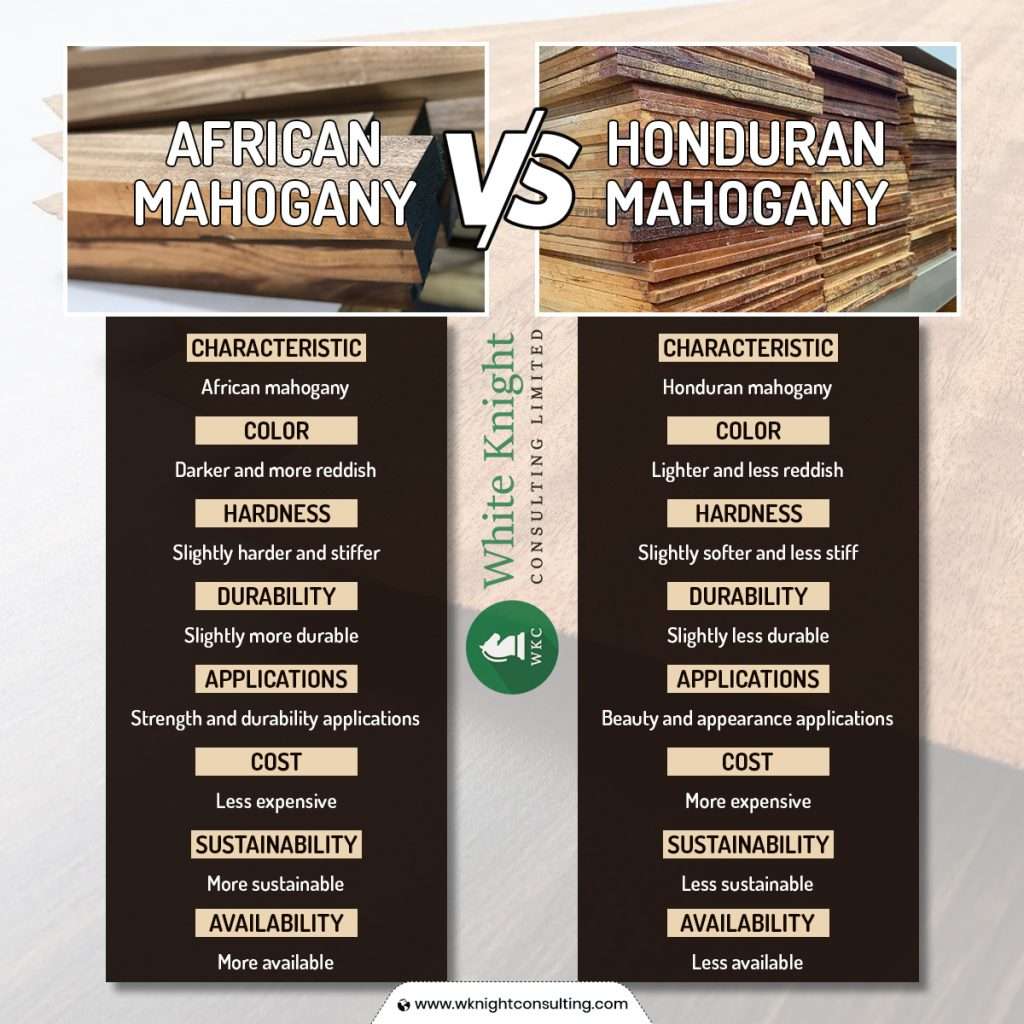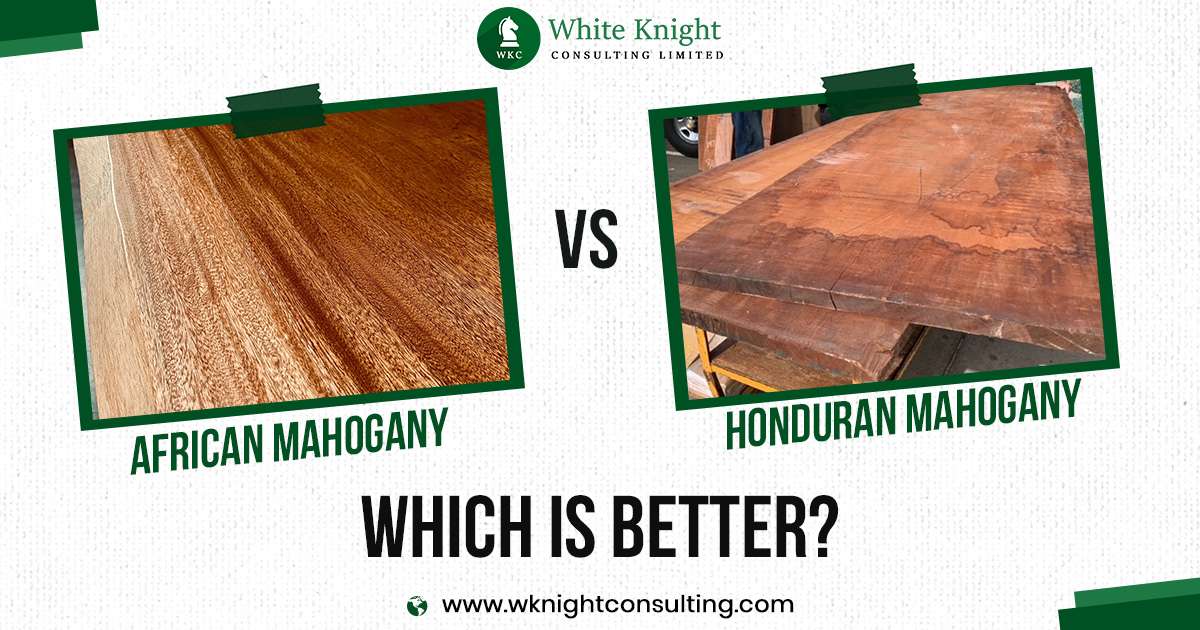When it comes to selecting wood for your woodworking projects, you want the best. Two hardwoods often vying for your attention are African and Honduran Mahogany. Both have earned their place in the woodworking world, but they come from different parts of the globe and have unique qualities. In this detailed comparison, we’ll explore African Mahogany vs Honduran Mahogany in depth, considering their origins, physical characteristics, workability, applications, and sustainability.
African Mahogany vs Honduran Mahogany : Key Differences
Discover the essential distinctions between these two wood types in the table below:

Origins and Species
1.1 African Mahogany (Khaya spp.)
- Origins: African Mahogany primarily hails from West and Central Africa, with species like Khaya ivorensis and Khaya senegalensis being the most prevalent.
- Appearance: Its heartwood ranges from pale pink to reddish-brown, often displaying an exquisite ribbon-like grain.
- Density: It is moderately dense, making it versatile for various applications.
1.2 Honduran Mahogany (Swietenia macrophylla)
- Origins: Sometimes referred to as “genuine mahogany,” comes from Central & South America, with a historical stronghold in Honduras.
- Appearance: This wood is known for its rich, reddish-brown color, which deepens with age. Its fine, straight grain is visually striking.
- Density: It boasts moderate density, offering exceptional workability.
Physical Properties
2.1 Color and Grain Pattern
- African Mahogany exhibits a pleasing range of pale pink to reddish-brown hues and its signature ribbon-like grain pattern.
- Honduran Mahogany is celebrated for its deep, reddish-brown color that matures beautifully with time. Its fine, even grain adds to its aesthetic appeal.
2.2 Density and Hardness
- African Mahogany has a moderate density with a Janka hardness rating of approximately 900 lbf. This makes it suitable for various woodworking tasks.
- Honduran Mahogany, with a Janka hardness of 800-900 lbf, is renowned for its ease of carving, shaping, and finishing.
Workability
3.1 Ease of Machining
- African Mahogany is well-known for its smooth machining properties, making it a favorite among woodworkers. It responds well to cutting, routing, & sanding.
- Honduran Mahogany’s workability is legendary, as it cuts with exceptional ease, allowing for intricate detailing and precise joinery.
3.2 Finishing
- African Mahogany takes stains and finishes beautifully, enhancing its natural color and grain. It polishes to a fine sheen, adding a touch of elegance to any project.
- Honduran Mahogany exhibits excellent finishing properties, accepting stains and varnishes with grace to achieve a stunning, lustrous surface.
Applications
4.1 African Mahogany Applications
- Furniture: It is a top choice for crafting fine furniture, cabinets, and veneers due to its attractive appearance and workability.
- Musical Instruments: Its resonance and tonal qualities make it a preferred wood for constructing musical instruments like guitars.
- Boat Building: It’s moderate durability makes it suitable for boat building, especially for interior components.
4.2 Honduran Mahogany Applications
- Cabinetry: The wood’s aesthetic and workability make it a prime selection for crafting high-end cabinets, moldings, & paneling.
- Fine Woodworking: This wood is a staple for crafting luxurious woodworking pieces, including tables, chairs, and heirloom-quality items.
- Decorative Veneers: Its consistent grain pattern and rich color make it ideal for veneer applications in upscale interiors.
Sustainability and Conservation
5.1 African Mahogany Sustainability
- Challenges: Certain African Mahogany species face challenges related to overharvesting and habitat loss, raising conservation concerns.
- Sustainable Sourcing: The importance of responsible forestry practices and the use of certified lumber cannot be overstated.
5.2 Honduran Mahogany Sustainability
- Historical Concerns: It faced severe overharvesting in the past, which led to restrictions on its trade.
- Current Status: While conservation challenges persist, it is now more rigorously managed & regulated.
Making an Informed Choice
6.1 Choosing African Mahogany
- Opt for African Mahogany if you seek a wood with a striking grain pattern, moderate density, and excellent machining characteristics.
- Ensure you source it from reputable suppliers committed to sustainable practices.
6.2 Choosing Honduran Mahogany
- Select Honduran Mahogany if you prioritize ease of workability, deep rich color, and a wood that ages beautifully.
- Moreover, confirm that your Honduran Mahogany comes from legal and responsible sources.
Conclusion
In the realm of fine woodworking, both African Mahogany & Honduran Mahogany have secured their places as top contenders. Your choice should align with the specific requirements of your project, your workability preferences, and your commitment to sustainability.
At White Knight Consulting LTD, we understand the significance of this decision. As a trusted wood supplier with a reputation for excellence, we offer a wide range of top-quality hardwoods, including African and Honduran Mahogany, sourced responsibly from certified forests. Our commitment to providing wood of the highest caliber ensures that your woodworking projects not only shine with craftsmanship but also contribute to a sustainable future.
